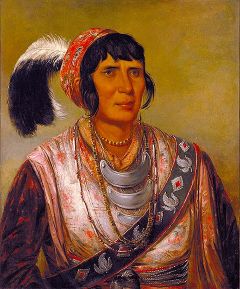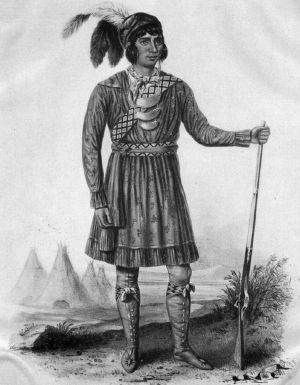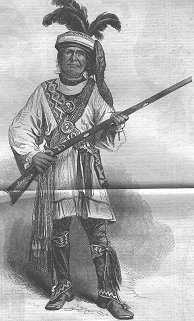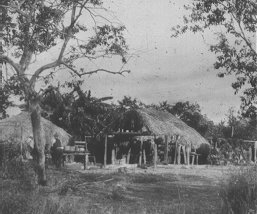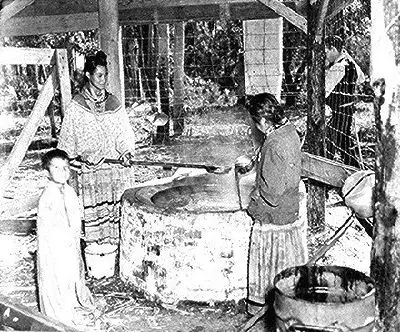Seminole
| Seminole |
|---|
| Seminole Chief Osceola (1804–1838) |
| Total population |
| est. 18,600 Seminole Nation of Oklahoma 15,572 enrolled Seminole Tribe of Florida 4,000 enrolled Miccosukee Tribe of Indians of Florida 400 enrolled |
| Regions with significant populations |
| United States (Oklahoma, Florida) |
| Languages |
| English, Miccosukee, Creek |
| Religions |
| Protestantism, other |
| Related ethnic groups |
| Five Civilized Tribes |
The Seminole are a Native American people originally of Florida, and now residing in that state and in Oklahoma. They were part of the Five Civilized Tribes—together with the Chicasaw, Choctaw, Creek, and Cherokee, so named because they had integrated numerous cultural and technological practices of their European American neighbors. However, the majority were forcibly removed to Oklahoma, herded westward along the Trail of Tears. Those who survived reorganized and established themselves in their new home.
The Seminole nation came into existence in the eighteenth century and was composed of people from Georgia, Mississippi, Alabama, and Florida, most significantly the Creek Nation, as well as African Americans who escaped from slavery in South Carolina and Georgia, known as the Black Seminoles. Today, they have sovereignty over their tribal lands, and an economy based on tobacco, tourism, and gambling. Despite being decimated by European-borne disease and terrible hardship during their forced removal, the Seminole continue to survive and have hope for a future in which they can be accepted and prosper.
History
After the Spanish conquest in the sixteenth century, the indigenous people of Florida were decimated by disease, and it is believed that the few survivors were evacuated by the Spanish to Cuba when Florida fell under British rule in 1763.
In the early eighteenth century, members of the Lower Creek Nation began migrating into Florida to remove themselves from the dominance of the Upper Creeks, and intermingled with the few remaining indigenous people there, some recently arrived as refugees after the Yamasee War such as the Yuchi, Yamasee, and others. They went on to be called "Seminole," a derivative of the Mvskoke, a Creek language word simano-li, an adaptation of the Spanish "cimarrón" which means "wild" (in their case, "wild men," or "runaway" men). The Seminole were a heterogeneous tribe made up of mostly Lower Creeks from Georgia, Mikasuki-speaking Muskogees, and escaped African American slaves, and to a lesser extent, white Europeans and Indians from other tribes. The unified Seminole spoke two languages, Creek and Mikasuki (a modern dialect similar to Hitchiti), two different members of the Muskogean Native American languages family, a language group that also includes Choctaw and Chickasaw. It is largely on linguistic grounds that the modern Miccosukee Tribe of Indians of Florida maintain their separate identity today.
The Seminole were on good terms with both the Spanish and the British. In 1784, the treaty ending the American Revolutionary War returned all of Florida to Spanish control. However, the Spanish Empire's decline allowed the Seminole to settle deeper into Florida. Until the majority of Seminoles were forced to move to the Indian Territory (modern Oklahoma) after the Second Seminole War, the Seminole were led by a dynasty of chiefs founded in the eighteenth century by Cowkeeper.
The Seminole Wars
After attacks by Spanish settlers on Indian towns, Indians based in Florida began raiding Georgia settlements, purportedly at the behest of the Spanish. The U.S. Army led increasingly frequent incursions into Spanish territory to recapture escaped slaves, including the 1817–1818 campaign against the Seminole Indians by Andrew Jackson that became known as the First Seminole War. In the following the war, the United States effectively controlled East Florida.
The Adams-Onís Treaty was signed between the United States and Spain in 1819, and took effect in 1821. According to the terms of the treaty, the United States acquired Florida and, in exchange, renounced all claims to Texas. Andrew Jackson was named military governor of Florida. As American settlement increased after the treaty, pressure grew on the Federal government to remove the Indians from their lands in Florida. Many Indian tribes harbored runaway black slaves, and the settlers wanted access to Indian lands. Georgian slave owners also wanted the maroons and fugitive slaves living among the Seminoles, known today as Black Seminoles, returned to slavery.
The Five Civilized Tribes is the term applied to five Native American nations, the Cherokee, Chickasaw, Choctaw, Creek, and Seminole, considered "civilized" by white society because they had adopted many of the colonists' customs and had generally good relations with their neighbors. When the tribes are discussed together, sometimes the modified label "Five Tribes" is used to avoid the suggestion that other indigenous peoples were savages.
The Trail of Tears refers to the forced relocation in the 1830s of the forced migration to Oklahoma of the Seminole, and other members of the five civilized tribes. The phrase originated as a description of the forcible removal of the Choctaw nation in 1831. Thousands of Seminoles were forcibly removed from their Floridian homelands and forced to march to Oklahoma. Once the tribes had been relocated to Indian Territory, the United States government promised that their lands would be free of white settlement. However, settlers violated the agreement with impunity.
In 1832, the United States government signed the Treaty of Paynes Landing with a few of the Seminole chiefs, promising them lands west of the Mississippi River if they agreed to leave Florida voluntarily. The remaining Seminole prepared for war. White settlers pressured the government to remove all of the Native Americans, by force if necessary. In 1835, the U.S. Army arrived to enforce the treaty. Seminole leader Osceola led the vastly outnumbered resistance during the Second Seminole War. Drawing on a population of about 4,000 Seminole Indians and 800 allied Black Seminoles, the Seminoles mustered at most 1,400 warriors (Andrew Jackson estimated they had only 900) to counter combined U.S. Army and militia forces that ranged from 6,000 troops at the outset to 9,000 at the peak of deployment, in 1837. To survive, the Seminole allies employed hit-and-run guerrilla tactics with devastating effect against U.S. forces. Osceola was arrested when he came under a flag of truce to negotiations in 1837. He died in jail less than a year later. His body was buried without his head.
Other warchiefs such as Halleck Tustenuggee, Jumper, and Black Seminoles Abraham and John Horse continued the Seminole resistance against the army. The war only ended, after a full decade of fighting, in 1842. The U.S. government is estimated to have spent about $20,000,000 on the war, at the time an astronomical sum. Many Native Americans were forcibly exiled to Creek lands west of the Mississippi; others retreated into the Everglades.
While roughly 3,000 Seminoles were forced west of the Mississippi River, including the Seminole Nation of Oklahoma who picked up new members along their way, approximately 300 to 500 Seminoles stayed and fought in and around the Everglades of Florida. In the end, the government gave up trying to subjugate the Seminole in their Everglades redoubts and left less than 100 Seminoles in peace.[1] The Seminoles never surrendered to the United States government, hence, the Seminoles of Florida call themselves the "Unconquered People." The Florida Seminoles are the only American Indian tribe never to sign a formal peace treaty with the United States.[2]
The Five Tribes were divided during the American Civil War as to which side to support. The Choctaw and Chickasaw fought predominantly on the Confederate side, while the Creek, Seminole and especially the Cherokee were split between the Union and the Confederacy. The Cherokee fought a civil war within their own nation between those who supported the opposing sides.
Culture
The Seminoles survived by hunting and fishing for centuries. The traditional Seminole clothing was decorated with bright colors. Seminole women wore large amounts of beads, which was a fascinating phenomenon for the European settlers, who regarded these intricate and colorful costumes with great reverence.
Seminoles were experts in the area of basket weaving. Although skilled in other mediums such as totem wood carvings and crafting meticulous weapons such as longbows and copper arrowheads, making baskets was an efficient and practical art form, as they were largely a hunter-gatherer culture.
The Seminole developed the Chickee style of building houses. This simple shelter construction was developed in the early 1800s, during the Seminole Wars, when they needed housing that was quick to erect and disposable since they had to move their camps quickly and often to escape the U.S. troops. Made from palmetto thatch over a bald cypress log frame, the chickee also has a raised wooden platform to provide cooling and protection from animals, insects, and flooding.
Seminole legends have been passed down over the generations by word of mouth throughout the clans. A story-teller is greatly revered, and must be responsible for telling the story as close to the original version as possible. The recipient of a legend must do his or her best to retell the story as close to the original version as possible. It is a great responsibility and for this reason, the best storytellers are greatly respected among those in the tribe.
Medicine men and women, and shamans still play a vital role in the lives of Seminole Indians. These individuals do not replace modern medical doctors, but serve to maintain a traditional balance to heal the spirit, mind, and body.
Contemporary
Today, Seminoles have sovereignty over their tribal lands, and an economy based on tobacco, tourism, and gambling.
Two of the Seminole tribes are called "Freedmen Bands" (also "Black Seminole") because they count their descent from escaped slaves. Band membership is matrilineal: Children are members of their mother's band. The group is ruled by an elected council, with two members from each band. The capital is at Wewoka, Oklahoma.
The Miccosukee Tribe of Indians of Florida was formed in the 1960s by members of the Florida Seminole community who were unsatisfied with the Seminole Tribe of Florida; they were largely Mikasuki-speaking descendants of the Chiaha, or Upper Chehaw, who had originally lived in the Tennessee Valley as opposed to the majority of Seminoles who spoke Creek. The Miccosukee Tribe set up a 33-acre reservation on the northern border of Everglades National Park, about 45 miles west of Miami.
The Seminole Tribe of Florida and the Miccosukee Tribe of Indians of Florida entered into agreements with the US government in 1957 and 1962, respectively, confirming their sovereignty over tribal lands and agreeing to compensation for seized territory. Since then, the tribes have developed an economy based largely on sales of duty-free tobacco, tourism, and gambling. On December 7, 2006, they purchased a chain of restaurants.[3]
When South Florida tourism boomed in the 1920s, Seminoles capitalized by wrestling alligators for money. In 1979, the Seminoles opened the first casino on Indian land, ushering in what has become a multibillion-dollar industry operated by numerous tribes nationwide.[2]
In more recent years, the Miccosukee Tribe has sustained itself by owning and operating a casino, resort, a golf club, several museum attractions, and the "Indian Village." At the "Indian Village," Seminoles demonstrate traditional pre-Columbian lifestyles to educate people regarding their culture.
The use of "Seminole" as a namesake is common in Florida, with one county named after them, Seminole County, Florida, and another named after Seminole leader Osceola, Osceola County, Florida. There is also a city named for them in Pinellas County,—Seminole, Florida.
The image and name of the Seminole chief, Osceola, serves as a symbol for Florida State University and several high school athletic programs in the state also use the nickname, "Seminoles." According to The New York Times article "Florida State Can Keep Its Seminoles," the National Collegiate Athletic Association (NCAA) prohibition of Native American logos, signs in stadiums, cheerleader and band uniforms, and mascots as presumed "hostile and abusive" did not apply to FSU and the Seminoles. FSU was exempt as both the 3,100-member Seminole Tribe of Florida and the 6,000-member Seminole Nation of Oklahoma officially approved the relationship and the details of the images used. The article states:
The Seminoles are the only American Indian tribe never to sign a formal peace treaty with the United States. To celebrate this status, Florida State erected Unconquered, a statue of Chief Osceola outside its football stadium."[2]
Notes
- ↑ James W. Covington, The Seminoles of Florida (Gainesville, FL: University Press of Florida, 1993, ISBN 0813011965).
- ↑ 2.0 2.1 2.2 Robert Andrew Powell, Florida State Can Keep Its Seminoles The New York Times (August 24, 2005). Retrieved November 24, 2023.
- ↑ Seminoles to buy Hard Rock chain Market Watch (December 7, 2006). Retrieved November 24, 2023.
ReferencesISBN links support NWE through referral fees
- Covington, James W. The Seminoles of Florida. Gainesville, FL: University Press of Florida, 1993. ISBN 0813011965
- Foreman, Grant. Indian Removal: The Emigration of the Five Civilized Tribes of Indians. Norman, OK: University of Oklahoma Press, 1972. ISBN 0806111720
- Missall, John, and Mary Lou Missall. The Seminole Wars: America's Longest Indian Conflict. Gainesville, FL: University Press of Florida, 2004. ISBN 0813027152
- Waldman, Carl. Encyclopedia of Native American Tribes. Checkmark Books, 2006. ISBN 978-0816062744
- Wickman, Patricia Riles. Osceola's Legacy. Fire Ant Books, 2006. ISBN 978-0817353322
External links
All links retrieved November 24, 2023.
- Tribe of Florida official site.
- The sovereign Miccosukee Seminole Nation official site.
- Seminole Doll Making Florida Memory.
- John Horse and the Black Seminoles, First Black Rebels to Beat American Slavery.
- The Seminole Indians of Florida, by Clay MacCauley, 1884, Smithsonian Institute, Bureau of Ethnology, from Project Gutenberg.
| |||||
Credits
New World Encyclopedia writers and editors rewrote and completed the Wikipedia article in accordance with New World Encyclopedia standards. This article abides by terms of the Creative Commons CC-by-sa 3.0 License (CC-by-sa), which may be used and disseminated with proper attribution. Credit is due under the terms of this license that can reference both the New World Encyclopedia contributors and the selfless volunteer contributors of the Wikimedia Foundation. To cite this article click here for a list of acceptable citing formats.The history of earlier contributions by wikipedians is accessible to researchers here:
The history of this article since it was imported to New World Encyclopedia:
Note: Some restrictions may apply to use of individual images which are separately licensed.
